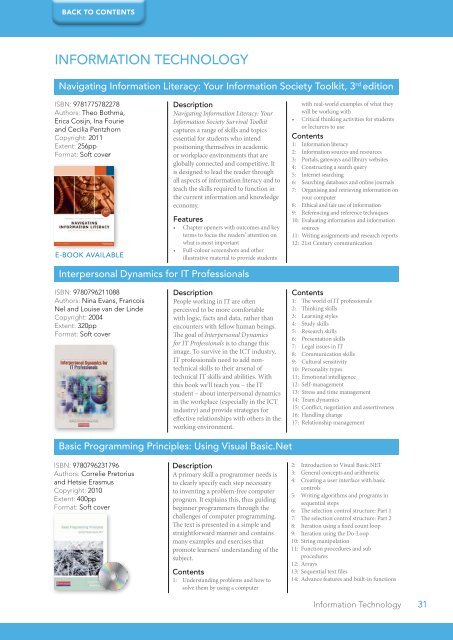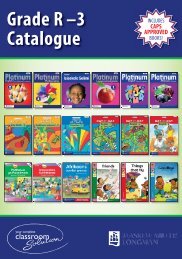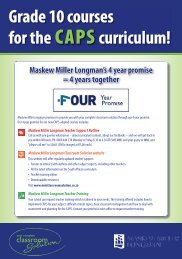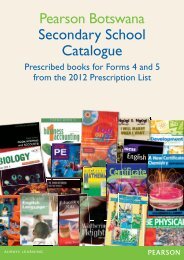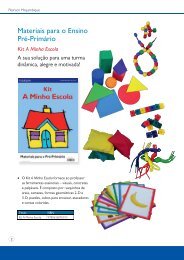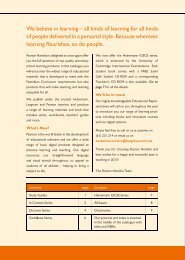Download - Pearson
Download - Pearson
Download - Pearson
You also want an ePaper? Increase the reach of your titles
YUMPU automatically turns print PDFs into web optimized ePapers that Google loves.
BACK TO CONTENTS<br />
INFORMATION TECHNOLOGY<br />
Navigating Information Literacy: Your Information Society Toolkit, 3 rd edition<br />
ISBN: 9781775782278<br />
Authors: Theo Bothma,<br />
Erica Cosijn, Ina Fourie<br />
and Cecilia Pentzhorn<br />
Copyright: 2011<br />
Extent: 256pp<br />
Format: Soft cover<br />
E-BOOK AVAILABLE<br />
Description<br />
Navigating Information Literacy: Your<br />
Information Society Survival Toolkit<br />
captures a range of skills and topics<br />
essential for students who intend<br />
positioning themselves in academic<br />
or workplace environments that are<br />
globally connected and competitive. It<br />
is designed to lead the reader through<br />
all aspects of information literacy and to<br />
teach the skills required to function in<br />
the current information and knowledge<br />
economy.<br />
Features<br />
• Chapter openers with outcomes and key<br />
terms to focus the readers’ attention on<br />
what is most important<br />
• Full-colour screenshots and other<br />
illustrative material to provide students<br />
with real-world examples of what they<br />
will be working with<br />
• Critical thinking activities for students<br />
or lecturers to use<br />
Contents<br />
1: Information literacy<br />
2: Information sources and resources<br />
3: Portals, gateways and library websites<br />
4: Constructing a search query<br />
5: Internet searching<br />
6: Searching databases and online journals<br />
7: Organising and retrieving information on<br />
your computer<br />
8: Ethical and fair use of information<br />
9: Referencing and reference techniques<br />
10: Evaluating information and information<br />
sources<br />
11: Writing assignments and research reports<br />
12: 21st Century communication<br />
Interpersonal Dynamics for IT Professionals<br />
ISBN: 9780796211088<br />
Authors: Nina Evans, Francois<br />
Nel and Louise van der Linde<br />
Copyright: 2004<br />
Extent: 320pp<br />
Format: Soft cover<br />
Description<br />
People working in IT are often<br />
perceived to be more comfortable<br />
with logic, facts and data, rather than<br />
encounters with fellow human beings.<br />
The goal of Interpersonal Dynamics<br />
for IT Professionals is to change this<br />
image. To survive in the ICT industry,<br />
IT professionals need to add nontechnical<br />
skills to their arsenal of<br />
technical IT skills and abilities. With<br />
this book we’ll teach you – the IT<br />
student – about interpersonal dynamics<br />
in the workplace (especially in the ICT<br />
industry) and provide strategies for<br />
effective relationships with others in the<br />
working environment.<br />
Contents<br />
1: The world of IT professionals<br />
2: Thinking skills<br />
3: Learning styles<br />
4: Study skills<br />
5: Research skills<br />
6: Presentation skills<br />
7: Legal issues in IT<br />
8: Communication skills<br />
9: Cultural sensitivity<br />
10: Personality types<br />
11: Emotional intelligence<br />
12: Self-management<br />
13: Stress and time management<br />
14: Team dynamics<br />
15: Conflict, negotiation and assertiveness<br />
16: Handling change<br />
17: Relationship management<br />
Basic Programming Principles: Using Visual Basic.Net<br />
ISBN: 9780796231796<br />
Authors: Correlie Pretorius<br />
and Hetsie Erasmus<br />
Copyright: 2010<br />
Extent: 400pp<br />
Format: Soft cover<br />
Description<br />
A primary skill a programmer needs is<br />
to clearly specify each step necessary<br />
to inventing a problem-free computer<br />
program. It explains this, thus guiding<br />
beginner programmers through the<br />
challenges of computer programming.<br />
The text is presented in a simple and<br />
straightforward manner and contains<br />
many examples and exercises that<br />
promote learners’ understanding of the<br />
subject.<br />
Contents<br />
1: Understanding problems and how to<br />
solve them by using a computer<br />
2: Introduction to Visual Basic.NET<br />
3: General concepts and arithmetic<br />
4: Creating a user interface with basic<br />
controls<br />
5: Writing algorithms and programs in<br />
sequential steps<br />
6: The selection control structure: Part 1<br />
7: The selection control structure: Part 2<br />
8: Iteration using a fixed count loop<br />
9: Iteration using the Do-Loop<br />
10: String manipulation<br />
11: Function procedures and sub<br />
procedures<br />
12: Arrays<br />
13: Sequential text files<br />
14: Advance features and built-in functions<br />
Information Technology<br />
31


